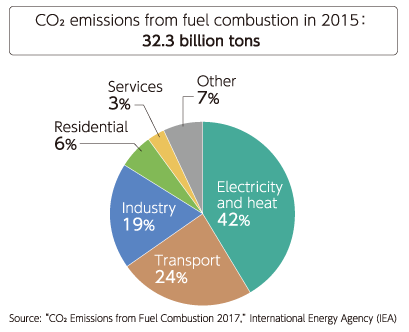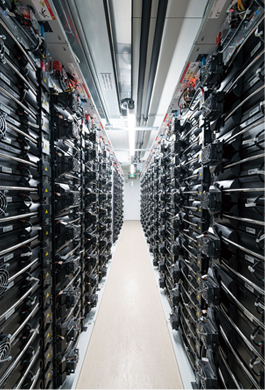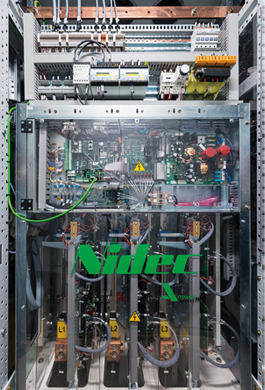Special Feature 2018 - Our Contribution to a Sustainable World
1. Driving a Decarbonized Society
Facing the threat of climate change, the international community has chosen to achieve a decarbonized society in the Paris Agreement. The Nidec Group helps accelerate the decarbonization of the global energy system by developing module systems that incorporate high-performance motors and related products and providing power management solutions that support the spread of renewable energy.
What Changed after the Paris Agreement
The Paris Agreement was adopted in December 2015 at the 21st session of the Conference of the Parties to the United Nations Framework Convention on Climate Change (COP 21) and entered into force in November 2016. It aims to limit the rise in global average temperatures to well below 2℃ on pre-industrial averages, with efforts to limit warming to 1.5℃. To this end, it is required to achieve net-zero carbon emissions in the second half of this century by balancing human-caused greenhouse gas emissions with greenhouse gases absorbed by plants. This decarbonizing movement will fundamentally steer the future course of global socioeconomic activities. It will be required to dramatically reduce CO2 emissions from energy use and expand non-fossil fuel-based energy sources. In the SDGs, Goal 7 for energy and Goal 13 for climate action have been established to promote the decarbonization of the global energy system.

Toward a Society Independent of Fossil Fuels
According to the International Energy Agency (IEA), power generation and heat supply account for the largest portion of global CO2 emissions (42%), followed by vehicles and other transportation (24%). An improvement in energy use efficiency and a switchover from fossil fuels, which have been the mainstream fuels for power generation, to renewable sources will promote the decarbonization of the global energy system.

Power System That Promotes the Spread of Renewable Energy
The IEA reports that the CO2 emission rate is the highest when electricity is generated. To achieve the decarbonization of the global energy system, it is essential to switch from thermal power generation to power generation from renewable energy sources, including sunlight, wind power and water power. However, renewable energy has not yet fully been spread. One of the factors is that it cannot provide stable power generation. For instance, since electric power generation from solar and wind energy fluctuates significantly depending on the climate and weather conditions of the moment, the power generation is often insufficient or excessive according to the circumstances.
Nidec ASI S.p.A., which has developed power system technologies for over 100 years, is comprehensively engaged in generating, storing, transmitting and distributing renewable energy. It provides system solutions to stably supply low-cost power even to distant areas, including isolated islands and remote rural areas. Serving as a core element of the solutions is microgrid technology, which enables optimal power management by integrating various electric generators, such as solar and wind generators, with storage batteries. Nidec ASI has an advantage in battery energy storage systems (BESSs), which play an important role in microgrid technology development.
The use of BESSs allows for a reliable supply of power through the temporary storage of surplus power and the release of stored electricity at times of power shortage. We have implemented projects aimed at building large-scale BESSs in the UK and Germany and on the French island of Corsica. The total global energy capacity of these systems exceeded 500 MW during 2017. An energy capacity of 500 MW is considered to be able to cover the power consumption of approximately 100,000 households.
 |
 |
|
Battery Energy Storage System (BESS) |
Power conversion system essential for BESS |
Improving Energy Efficiency with the Use of High-performance Motors
In terms of the consumption of generated power, approximately 50% of global power consumption is said to be attributed to motors. Accordingly, the Nidec Group also focuses on reducing the power consumption of motors.
For motors for industrial use, we have been supplying IE3-level motors (premium efficiency) since 2014 to support the energy conservation of production facilities, such as carrier machines and air blowers. According to a provisional calculation by the Japan Electrical Manufacturers' Association in 2015, if the majority of industrial motors (IE1) used in Japan are replaced entirely by IE3-level motors, power consumption of as much as approximately 15,000,000 MWh can be reduced annually. Furthermore, we have developed higher-performance IE4- and IE5-level motors.
For motors for consumer use, it is important to improve the energy efficiency of air conditioners and air-conditioning equipment with large power consumption. Our brushless DC motors for inverter air conditioners, one of the Nidec Groupʼ s flagship products, can realize optimal control of systems. We supply air conditioner manufacturers with high-efficiency motors modularized with blowing motors and inverter circuits. We also provide brushless DC motors for a wide range of applications, including refrigerators, washing machines, cooking appliances and AV equipment, to improve the energy efficiency of the entire indoor space.
Motors That Support Vehicle Electrification

Transportation accounts for the second largest share, 24% of overall CO2 emissions, right after power generation. The majority of these CO2 emissions is attributed to vehicles fueled by gasoline or diesel. Vehicles are currently in the midst of a once-in-a-century technological innovation, in the transition from engine-driven to motor-driven vehicles. With the effectuation of the Paris Agreement, there has been a movement to tighten CO2 emission regulations and ban the use of gasoline-fueled vehicles in various countries, in which a direction toward vehicle electrification has been established.
The Nidec Group provides high-efficiency motors for all vehicle systems with the basic functions of driving, turning and stopping. These systems include a traction system, which generates the driving force necessary for the motion of the vehicle, an electric power steering (EPS) device, which assists the operation of the steering wheel, and a brake system.
In April 2018, we launched a traction motor system, the “E-Axle,” developed for electric vehicles (EVs) and plug-in hybrid vehicles (PHEVs). Featuring excellent performance as a motor system as well as reduced size and weight due to a uniquely developed new cooling system, this traction motor system has contributed to the realization of high-efficiency and fuel-efficient vehicles.

